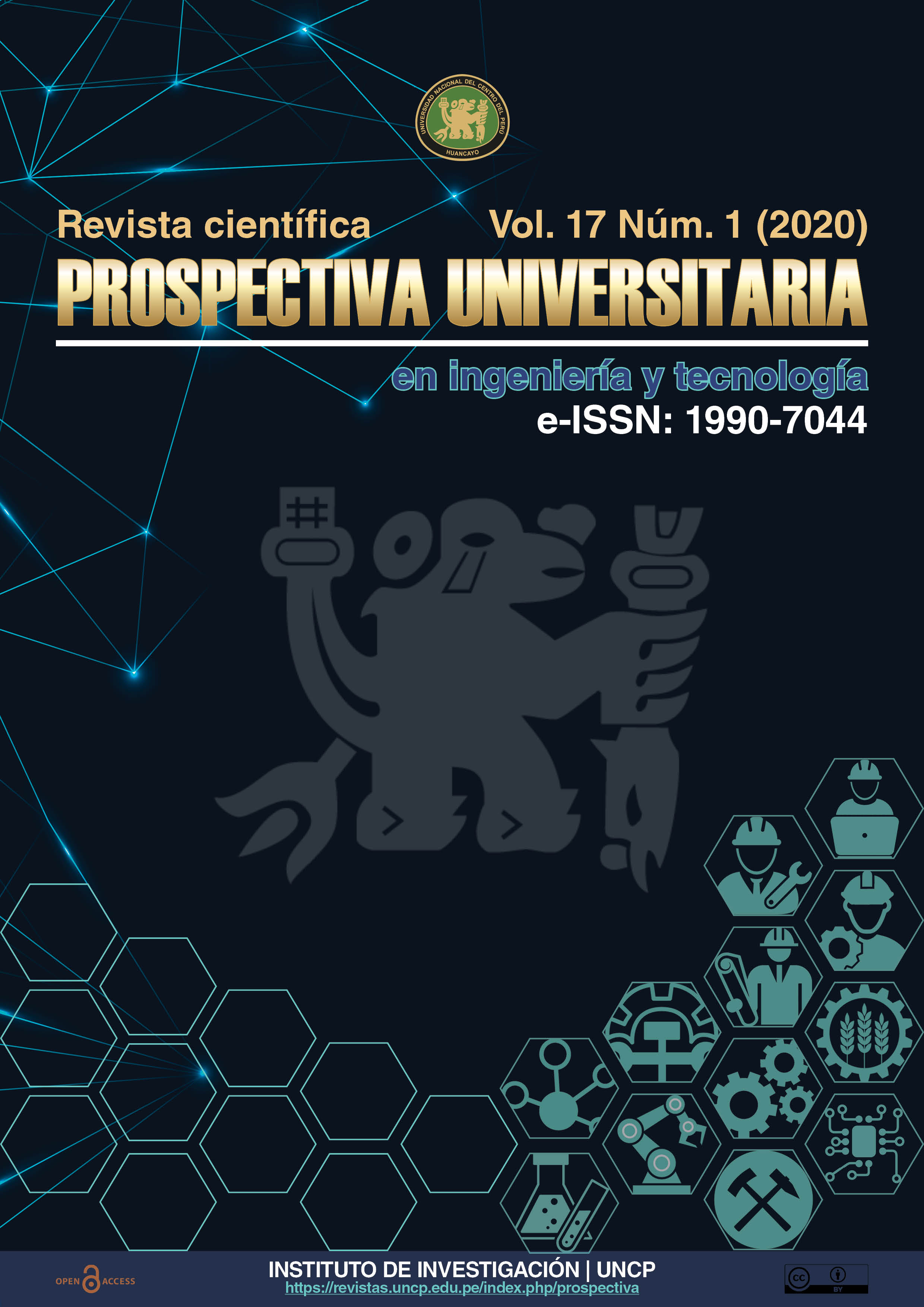Pérdida de carga en un sistema de tuberías de agua: comparación de resultados experimentales mediante el equipo HM 150.61
DOI:
https://doi.org/10.26490/uncp.prospectivauniversitaria.2020.17.1388Palabras clave:
Pérdida de carga, Sistema de tuberías, Medición experimental, Medición electrónica, HidráulicaResumen
El trabajo consistió en comparar los resultados de pérdida de carga obtenidos de manera experimental mediante el equipo HM 150.61, en un sistema de tuberías de agua. La medición de los datos primigenios se realizó con los instrumentos artesanales y el cálculo en una hoja de cálculo Excel, y para la medición electrónica se utilizó el equipo HM 150.61 que cuenta con sensores de medición, proveído por la empresa Gunt Hamburg.
El objetivo principal fue determinar la desviación entre la medición experimental y electrónica, pudiendo evidenciar que existe poca desviación; y se comprobó la efectividad de dicho equipo como medio de aprendizaje para los estudiantes de ingeniería y carreras afines; también la medición con el equipo y los resultados experimentales muestran la efectividad de combinar los dos métodos para medir y estimar las pérdidas de carga y poder tomar decisiones mucho más acertadas a la hora de ejecutar proyectos de redes de distribución de agua potable. Se determina el comportamiento de la curva de pérdida de carga, para calcular la potencia de bomba necesaria para hacer circular el agua en un sistema de tuberías.
Descargas
Referencias
Çengel Yunus A. & Cimbala John M. (2012). Mecánica de fluidos Fundamentos y aplicaciones. Ed. Mc Graw Hill; Segunda ed.
Dolinšek, S.; Bavec, C.; Mihelič, A. & Prodan, I.(2002). Upravljanje technologije - Ključ konkurenčnosti. Strojniski Vestnik/Journal of Mechanical Engineering, 48(3), 178–182.
Giustolisi, O.; Kapelan, Z. & Savic, D. (2007). A hydraulic simulation model for pipe networks with leakage outflows and pressure-driven demands. Restoring Our Natural Habitat - Proceedings of the 2007 World Environmental and Water Resources Congress.
Http://e-ducativa.catedu.es/. (n.d.). Ecuación de continuidad. Retrieved March 10, 2020, from http://e-ucativa.catedu.es/44700165/aula/archivos/repositorio/4750/4918/html/22_ecuacin_de_continuidad.html
Indirect full span calibration method for a digital vacuometer in cities above sea level. (s/f). Retrieved March 10, 2020, from http://www.scielo.org.co/scielo.php?script=sci_arttext&pid=S0121-44702016000200002#f1
Liu, J. & Yu, G. (2014). Analysis of demand and leakage distributing uniformly along pipes. Procedia Engineering, 89, 603–612. https://doi.org/10.1016/j.proeng.2014.11.484
Morales, M. D. (2016). Levıtatıon and suspensıon forces measurement system for hıgh tc superconductors. Momento, 60, 55–66. https://doi.org/10.15446/mo.n60.84228
Rivas, A., & Sánchez, G. (n.d.). Pérdıdas de carga en los componentes de las ınstalacıones hıdráulıcas. Retrieved March 7, 2020, from https://www.academia.edu/28988933/PÉRDIDAS_DE_CARGA_EN_LOS_COMPONENTES_DE_LAS_INSTALACIONES_HIDRÁULICAS
Sandoval, C.; Caram, J. & Salinas, J. (2009). La engañosa simplicidad del quote;método de Stokesquote; para medir viscosidades. Revista Brasileira de Ensino de Fisica, 31(4), 4310–4322. https://doi.org/10.1590/s1806-11172009000400012
Stadelmann, W., & Lutz, F. M. (1990). Vereinfachte Berechnung von Stromungs - druckverlusten in hydraulischen Systemen. BWK:BRENNSTOFF WARME KRAFT, 42(3, Mar., 1990), 124–128.
Wuennenberg, W.; George, D.; Habermehl, D. & Rohde, W. (1984). Unsetzung von ungereinigtem koksofengas im schwingrohr. Gluckauf: Die FachzeitschriftFur Rohstoff, Bergbau Und Energie, 120(9), 155–156, 557.
Zhu, X., Cai, B. & Tu, Q. (2011). Head loss hydraulic calculation step by step for light and small sprinkler irrigation system. Paiguan Jixie Gongcheng Xuebao/ Journal of Drainage and Irrigation Machinery Engineering, 29(2), 180–184. https://doi.org/10.3969/j.issn.1674-8530.2011.02.18
Descargas
Publicado
Número
Sección
Licencia
Derechos de autor 2020 Marcial De La Cruz Lezama

Esta obra está bajo una licencia internacional Creative Commons Atribución-NoComercial-CompartirIgual 4.0.
Esta Revista es de acceso abierto a su contenido a través del Internet, poniendo a disposición de la comunidad científica los resultados de la investigación, de manera gratuita, para el intercambio del conocimiento desarrollado.
El contenidos de la Revista se distribuyen bajo la licencia Creative Commons Reconocimiento-NoComercial-CompartirIgual 4.0 Internacional.
![IconJournalPU [ESP] by Edgar Julian-Laime®](https://revistas.uncp.edu.pe/public/journals/1/pageHeaderLogoImage_es.png)









